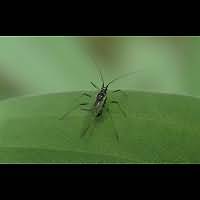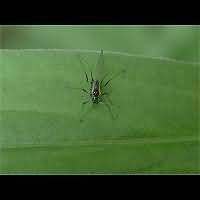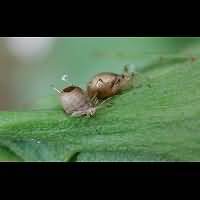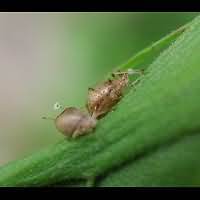Foxglove Aphid Aulacorthum solani
You might think that this is a species found on Foxglove exclusively. But alas, this species is very fond of many other plants as well. It can be found on various flowers in the garden as well as on potatoes in the fields. In greenhouses it likes both: flowers like Gerbera and Chrysanthemum and vegetables such as lettuce and egg plants. It is extremely harmful in greenhouses growing peppers, for many pepper species react "allergic" to the louse's bite. There are chemicals to kill the Foxglove Aphid, but parasitic wasps of the genus Aphelinus apparently are just as efficient.
Because there are so many plant lice around, they have a lot of enemies. In agriculture some of these enemies are even bred and sold to farmers and owners of greenhouses. Some of the best known are the various Ladybeetles and Lacewings. Less known, but very succesful are various parasitic wasps. Many of these are even much smaller than the plant louse itself. Most parasitic wasps have so called ovipositors: a kind of injection needle used to drill into victims in order to lay an egg. Once an egg is deposited in a plant louse, the animal starts to react in a strange way: it grows bigger, climbs on top of a leaf and becomes brownish. Why it climbs on top of a leaf is a complete mystery. Healthy plant lice can only be found on the other side, safe from many enemies! When it hatches, the parasite cuts a nice round hole in the back of the plant louse, through which hole it leaves his host.
Do mind please: we are not sure at all the infected Aphids in the bottom pictures actually are Foxglove Aphids. They could be though, for infected Aphids all react in more or less the same way.
You might think that this is a species found on Foxglove exclusively. But alas, this species is very fond of many other plants as well. It can be found on various flowers in the garden as well as on potatoes in the fields. In greenhouses it likes both: flowers like Gerbera and Chrysanthemum and vegetables such as lettuce and egg plants. It is extremely harmful in greenhouses growing peppers, for many pepper species react "allergic" to the louse's bite. There are chemicals to kill the Foxglove Aphid, but parasitic wasps of the genus Aphelinus apparently are just as efficient.
Because there are so many plant lice around, they have a lot of enemies. In agriculture some of these enemies are even bred and sold to farmers and owners of greenhouses. Some of the best known are the various Ladybeetles and Lacewings. Less known, but very succesful are various parasitic wasps. Many of these are even much smaller than the plant louse itself. Most parasitic wasps have so called ovipositors: a kind of injection needle used to drill into victims in order to lay an egg. Once an egg is deposited in a plant louse, the animal starts to react in a strange way: it grows bigger, climbs on top of a leaf and becomes brownish. Why it climbs on top of a leaf is a complete mystery. Healthy plant lice can only be found on the other side, safe from many enemies! When it hatches, the parasite cuts a nice round hole in the back of the plant louse, through which hole it leaves his host.
Do mind please: we are not sure at all the infected Aphids in the bottom pictures actually are Foxglove Aphids. They could be though, for infected Aphids all react in more or less the same way.







